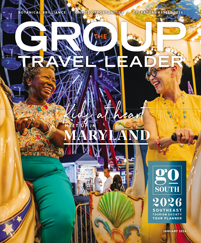To glimpse wild animals in their element is to see the world unfiltered and at its most beautiful.
Humans seek out wildlife in search of a natural and restorative break from the noisy, modern world. From the serenity of watching monarchs resting their wings in winter to the thrill of spotting North America’s most dangerous predators, here are some wildlife encounters across the country that will let groups experience the best of the natural world.
Wild Horse Tours
Crystal Coast, North Carolina
The origins of the wild horses found on some barrier island chains on the East Coast are a bit of a mystery. These Iberian horses descended from herds that may have migrated or been abandoned as early as the 1500s, but their exact journey through history is debated. The present-day herd of wild horses found near Crystal Coast, North Carolina, numbers about 110. They can be found on Shackleford Banks, part of the Cape Lookout National Seashore, and a separate strain of feral horses can be found on the Rachel Carson National Estuarine Research Reserve.
Many tour operators in the Crystal Coast area offer boat or kayak excursions to observe the horses as they graze on the island’s vegetation and frolic near the water. Cruises are narrated and can include time on Shackleford Banks for spotting horses and collecting seashells. Groups can also spot dolphins and marine birds along the way. Kayaking at the Rachel Carson Nature Reserve may allow for an even closer view of the horses and other wildlife. There are also plenty of beaches and hiking trails at the reserve.
Orca Watching Cruises
Friday Harbor, Washington
Orcas, also known as killer whales, aren’t whales at all. They’re really the largest species of dolphin and are noted for their intelligence, distinctive coloring and social behavior. Seeing these apex predators in their natural habitat — cold ocean waters — is a breathtaking experience.
The San Juan Islands, the island chain between Seattle and Victoria, Canada, is one of the best places to see orcas in the Pacific Northwest, and even has an island named for them, Orca Island. San Juan Safaris, based in the charming little town Friday Harbor, takes groups straight to the orcas. They offer several whale watching tours by boat for groups of up to 100. Groups can either attend public tours or charter a vessel for a private tour. Tours last between three and four hours and are offered daily from April to September.
Marine naturalists onboard will help groups spot the orcas as they come up to the surface of the water to breathe. There’s a good chance they’ll see other wildlife, including seals, bald eagles and sea lions, in addition to the beautiful views of the islands. Participants should dress in warm layers and bring binoculars or cameras to help them spot the whales.
Sea Turtle Hatching Walks
Juno Beach, Florida
Every species of sea turtle is considered endangered or threatened; that’s at least in part because of the tough odds they face from birth. Thanks to a long list of predators and a changing environment, it’s estimated only one out of every 1,000 hatchlings will survive to adulthood. That’s why sea turtle conservancy is such a dear cause to many coastal communities. Sea turtle rehabilitation facilities are one way to see these marine animals, but observing them in their natural habitat requires some expert knowledge.
The Loggerhead Marinelife Center in Juno Beach, Florida, provides this expertise and the opportunities for viewing sea turtles. In addition to tours of its sea turtle hospital, the center leads eco experiences that let groups observe turtles in a way that’s safe for the turtles. One option is the hatchling release, where the center’s staff releases sea turtle hatchlings from nests they excavated earlier in the day. The two-hour tour begins with a lesson on sea turtles and concludes with a walk to Juno Beach to watch the staff release the hatchlings.
Another option is an evening turtle walk, where groups will attempt to observe a sea turtle nesting. Tours are scheduled from 9 p.m. to midnight. Though turtle sightings aren’t guaranteed, Juno Beach is one of the top places for loggerhead turtles to nest.
Buffalo Roundup
Custer, South Dakota
To get an idea of what early westward pioneers may have seen as they ventured across the Great Plains, one only needs to see a vast herd of bison. Custer State Park in South Dakota offers visitors that chance with the Buffalo Roundup, where one of the world’s largest bison herds is gathered by cowboys and cowgirls on horseback. This roundup of the herd (estimated to contain over 1,300 bison) is necessary for the health of the herd and the park’s ecosystem. The bison are corralled, tested and treated for illnesses, branded and vaccinated. Some are sold to maintain a manageable herd size.
The event is quite the spectacle to the 14,000-plus visitors that travel to witness it. It’s typically held each September, with parking lots opening to the public about 6 a.m. on the day of the event, and the roundup itself beginning around 9:30 a.m. Groups can see the herd from designated viewing areas. Breakfasts are served in the viewing areas and lunch is served at the corrals for a fee. Groups can also bring their own snacks. The event is free, and the weekend it occurs is marked with festivals and additional activities.
Kodiak Bear Tours
Kodiak Island, Alaska
North America’s most fearsome predator is the grizzly bear. The Kodiak bear, a subspecies of grizzly bears, is found exclusively in Alaska’s Kodiak Archipelago. Kodiak bears can grow significantly larger than other grizzlies, growing up to 10 feet tall on their hind legs and weighing up to 1,500 pounds. Seeing these impressive predators in their pristine landscape is at the top of the list for many wildlife enthusiasts and photographers.
Kingfisher Aviation is a tour operator that has been taking visitors to see bears in the Alaskan wilderness for more than 25 years. These small tours can be booked May”“September and are good for small groups of up to 10. Tours last approximately four hours and kick off in Kodiak, where groups will board a floatplane and enjoy a scenic flight to a bear viewing spot, such as the Kodiak National Wildlife Refuge. There, they’ll view bears and other wildlife on the ground for about two hours. Guides are highly trained when it comes to safely viewing the bears.
Travelers should dress in layers and bring zoom lenses for their cameras if they plan to take photos. Since weather in Alaska can change quickly, it’s a good idea to plan multiple days in Kodiak so tours can be rescheduled around weather events.
Monarch Butterflies Wintering
Pacific Grove, California
Pacific Grove is sometimes called Butterfly Town, U.S.A. because of the large population of monarch butterflies that arrive each autumn as part of their annual migration. As many as 15,000 butterflies can be observed each year. Monarchs typically start arriving in Pacific Grove in October, and their population in the city peaks in early November through January. In early February, they migrate elsewhere. Visitors can witness these beautiful butterflies overwintering at the Monarch Grove Sanctuary, the city’s sanctuary for these gorgeous insects and one of the most populous monarch gathering spots in the state.
The monarchs cluster on tree branches in what’s called a chandelier, which can contain thousands of butterflies. They do this to conserve energy. On warm, sunny days at the sanctuary groups may see them flying around, while on cooler days, they’ll likely be clustered together.
Admission to the park is free. Volunteer docents from the Pacific Grove Museum of Natural History are usually present and can give groups more information about monarchs and help them spot the majestic creatures around the sanctuary. Sanctuary visitors should be mindful not to bother, chase or touch the monarchs and instead simply enjoy them at a distance.











